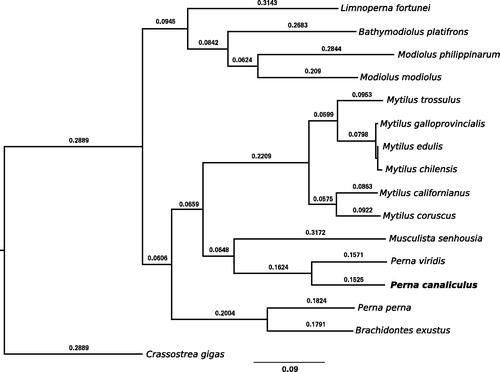Abstract
We describe here the first complete genome assembly of the New Zealand green-lipped mussel, Perna canaliculus, mitochondrion. The assembly was performed de novo from a mix of long nanopore sequencing reads and short sequencing reads. The genome is 16,005 bp long. Comparison to other Mytiloidea mitochondrial genomes indicates important gene rearrangements in this family.
The green-lipped mussel (Perna canaliculus Gmelin 1791, branded as ‘Greenshell™’ in aquaculture) is ecologically and economically important in New Zealand. Several mussels were collected on the west coast of the North Island of New Zealand. DNA extraction was performed on liquid nitrogen-homogenized samples following modified CTAB protocol (Winnepenninckx et al. Citation1993) and column extraction (Qiagen Inc., Valencia, CA). DNA extracted from 28 individuals was pooled and sequenced with an Oxford Nanopore Technologies MinIONTM sequencer. De novo genome assembly of the reads was performed using Canu (v1.5, Koren et al. Citation2017). A single long contig was identified to match the P. canaliculus mitochondrial cox1 and nd4 genes (Genbank DQ343591 and DQ343572). Subsequently, the sequencing reads aligning to this contig with high mapping quality (>30) were assembled using Unicycler (Wick et al. Citation2017) to obtain a circular genome reference.
One additional sample provided by the Cawthron Institute (Nelson, New Zealand) from an aquaculture long-line farm in Pelorus Sound (41°09′36.0″S 173°51′36.0″E, South Island, New Zealand), was analyzed for RNA sequencing on an Illumina HiSeq platform (Boyle Citation2016). The resulting ∼4.9 million short reads were aligned to the circular reference (mean coverage ∼37,987x for 99.86% of the reference) and the consensus sequence was constructed in Geneious (v10.2.3; Auckland, New Zealand). This step allowed us to build the mitochondrial genome for this specific individual (GenBank accession number MG766134).
The nucleotide composition of the 16,005 bp long mtDNA was 28.6% of A, 12.0% of C, 20.4% of G, and 39.0% of T for a GC content of 32.4%. Annotation was done in Geneious (v10.2.3; Auckland, New Zealand) using P. viridis as a reference (NC_018362) and the tRNA gene positions were confirmed with tRNAscan-SE (Lowe and Chan Citation2016). The circular genome contains 2 rRNA genes, 23 tRNA genes, and 13 protein-coding genes.
A total of 14 Mytiloidea species mitochondrial sequences could be retrieved at the time of the study: Bathymodiolus platifrons (NC_035421.1), Brachidontes exustus (NC_024882.1), Limnoperna fortunei (NC_028706.1), Modiolus modiolus (NC_033537.1), M. philippinarum (NC_035422.1), Musculista senhousia (NC_014590.1), Mytilus californianus (NC_015993.1), M. chilensis (NC_030633.1), M. coruscus (NC_024733.1), M. edulis (NC_006161.1), M. galloprovincialis (NC_006886.2), M. trossulus (NC_007687.1), P. perna (NC_026288.1) and P. viridis (NC_018362.1). Phylogenetic analysis was performed on concatenated protein-coding genes from all mitogenomes plus Crassostrea gigas (NC_001276.1): atp6, cox1, cox2, cox3, cytb, nd1, nd2, nd3, nd4, nd4l, nd5, nd6. Alignment was built for each gene independently with MUSCLE (Edgar Citation2004), sites were filtered with AliStat (Misof et al. Citation2014) and phylogenetic tree reconstructed with IQ-Tree (v1.5.4 Kalyaanamoorthy et al. Citation2017) and BEAST (v2.4.1 Bouckaert et al. Citation2014) resulting in identical topologies (). The closest relative to P. canaliculus was P. viridis; however, Wood et al. (Citation2007) reported a closest relationship to P. perna. Therefore, additional individual full genomes of Perna species are required to resolve their phylogeny. The gene order between P. canaliculus and P. viridis was compared using the R package genoPlotR (Guy et al. Citation2010) and showed the presence of several gene rearrangements in the mitochondrial genome (data not shown).
Disclosure statement
The authors report no conflicts of interest. The authors alone are responsible for the content and writing of this article.
Reference
- Bouckaert R, Heled J, Kühnert D, Vaughan T, Wu CH, Xie D, Suchard MA, Rambaut A, Drummond AJ. 2014. BEAST 2: a software platform for Bayesian evolutionary analysis. PLoS Computational Biology. 10:e1003537.
- Boyle L. 2016. Investigation of the heat stress response in Perna canaliculus at a transcriptomic and metabolomic level [master’s thesis]. Auckland (New Zealand): University of Auckland.
- Edgar RC. 2004. MUSCLE: multiple sequence alignment with high accuracy and high throughput. Nucleic Acids Res. 32:1792–1797.
- Guy L, Kultima JR, Andersson SGE. 2010. genoPlotR: comparative gene and genome visualization in R. Bioinformatics. 26:2334–2335.
- Kalyaanamoorthy S, Minh BQ, Wong TKF, von Haeseler A, Jermiin LS. 2017. ModelFinder: fast model selection for accurate phylogenetic estimates. Nat Methods. 14:587–589.
- Koren S, Walenz BP, Berlin K, Miller JR, Phillippy AM. 2017. Canu: scalable and accurate long-read assembly via adaptive k-mer weighting and repeat separation. Genome Research. 27:722–736.
- Lowe TM, Chan PP. 2016. tRNAscan-SE On-line: integrating search and context for analysis of transfer RNA genes. Nucleic Acids Res. 44:W54–W57.
- Misof B, Liu S, Meusemann K, Peters RS, Flouri T, Beutel RG, Niehuis O, Petersen M, Izquierdo-Carrasco F, Wappler T, et al. 2014. Phylogenomics resolves the timing and pattern of insect evolution. Science. 346:763–768.
- Wick RR, Judd LM, Gorrie CL, Holt KE. 2017. Unicycler: resolving bacterial genome assemblies from short and long sequencing reads. PLoS Comput Biol. 13:e1005595.
- Winnepenninckx B, Backeljau T, De Wachter R. 1993. Extraction of high molecular weight DNA from molluscs. Trends Genet. 9:407.
- Wood AR, Apte S, MacAvoy ES, Gardner JPA. 2007. A molecular phylogeny of the marine mussel genus Perna (Bivalvia: Mytilidae) based on nuclear (ITS1&ITS2) and mitochondrial (COI) DNA sequences. Mol Phylogenet Evol. 44:685–698.

